Modular Kitchen Design Guide for Practical Homes
A modular kitchen is a planned, component-based kitchen layout made from prefabricated cabinet sections and standardized fittings. It replaces custom carpentry with modular units that are designed to fit together, allowing faster installation, easier maintenance, and clear organization. This approach suits a range of home sizes and budgets because it emphasizes workflow, ergonomics, and adaptability while enabling choices in finishes, appliances, and storage.

What is a modular kitchen?
A modular kitchen is built from independent units—cabinets, drawers, tall units, and worktops—that are manufactured off-site and assembled on location. Each module performs a specific function and can be reconfigured or replaced without remaking the entire kitchen. This system makes planning simpler and helps coordinate plumbing, electrical, and appliance installations. For households that value predictable timelines and consistent quality control, modular kitchens reduce on-site carpentry time and often produce less waste than fully custom builds.
Designing a modern kitchen layout
A modern kitchen emphasizes clean lines, efficient workflow, and minimal visual clutter. Typical layouts include L-shaped, U-shaped, galley, and island configurations; the right choice depends on space, traffic patterns, and how you use the kitchen. Modern kitchen design also considers the “work triangle” (sink, stove, refrigerator) but adapts it for multi-cook households where multiple workstations and zones may be needed. Select durable, easy-to-clean surfaces and integrated storage to maintain a streamlined appearance while supporting everyday use.
Integrating smart appliances effectively
Smart appliances bring connectivity, automation, and energy monitoring to kitchen tasks. Common smart features include remote-control oven settings, refrigerator temperature alerts, voice-activated assistants, and dishwashers with cycle-sensing. When planning a modular kitchen, account for ventilation, dedicated circuits, and strong Wi-Fi where smart appliances will be concentrated. Prioritize interoperability and upgradeability—choose appliances that support standard protocols or can be updated so the kitchen can evolve without extensive refitting. Smart devices can enhance convenience and efficiency when integrated with the cabinet design and power layout.
Choosing sustainable materials
Sustainable materials reduce environmental impact and often improve indoor air quality. Options for modular kitchens include plywood or engineered wood with low-VOC adhesives, recycled or rapidly renewable countertops (bamboo, composite recycled glass), and metal or powder-coated fittings that last longer. Consider the entire lifecycle: durability reduces replacement frequency, and modular components can be swapped or reclaimed. Look for certifications such as FSC for wood products and low-emission ratings for finishes. Sustainable materials may influence cost and maintenance but can offer longer-term value and a smaller ecological footprint.
Optimizing storage solutions
Storage solutions are central to modular kitchens because standardized units allow a wide range of organizers and accessories. Deep drawers fitted with cutlery trays, pull-out pantries, corner carousels, and vertical dividers make use of otherwise wasted space. Plan for task-based storage: everyday utensils and frequently used pots near cooking areas, glassware by the dishwasher, and pantry items in tall pull-out units. Modular systems often include adjustable shelves and soft-close mechanisms that improve usability. Measuring typical items before choosing modules helps ensure that drawers and cabinets meet real storage needs.
Conclusion
A modular kitchen offers flexibility through standardized, replaceable components, making it easier to balance aesthetics, function, and maintenance. Modern kitchen principles—streamlined layouts and integrated appliances—work well with modular systems, while smart appliances and sustainable materials can be added in stages. Thoughtful storage solutions and planning help maximize usable space and support daily routines. When designing or renovating, focus on how you use the kitchen, prioritize durable finishes, and plan infrastructure for appliances and connectivity to extend the lifespan and usefulness of the modular layout.






